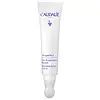What's inside
What's inside
 Key Ingredients
Key Ingredients

 Benefits
Benefits

 Concerns
Concerns

 Ingredients Side-by-side
Ingredients Side-by-side

Water
Skin ConditioningGlycerin
HumectantHydrogenated Coco-Glycerides
EmollientButyl Methoxydibenzoylmethane
UV AbsorberC12-15 Alkyl Benzoate
AntimicrobialCera Alba
EmollientDicaprylyl Carbonate
EmollientButylene Glycol
HumectantBehenyl Alcohol
EmollientBis-Ethylhexyloxyphenol Methoxyphenyl Triazine
Skin ConditioningButylene Glycol Dicaprylate/Dicaprate
EmollientEthylhexyl Triazone
UV AbsorberPhenylbenzimidazole Sulfonic Acid
UV AbsorberMethylpropanediol
SolventHydroxypropyl Starch Phosphate
Stearyl Alcohol
EmollientSodium Hyaluronate
HumectantArctium Lappa Fruit Extract
AntioxidantCreatine
Skin Conditioning1-Methylhydantoin-2-Imide
Skin ConditioningTocopherol
AntioxidantPalmitic Acid
EmollientStearic Acid
CleansingMyristic Acid
CleansingArachidic Acid
CleansingOleic Acid
EmollientSodium Stearoyl Glutamate
CleansingSodium Hydroxide
BufferingDiethylamino Hydroxybenzoyl Hexyl Benzoate
UV FilterLauroyl Lysine
Skin ConditioningXanthan Gum
EmulsifyingSodium Chloride
MaskingTrisodium EDTA
1,2-Hexanediol
Skin ConditioningEthylhexylglycerin
Skin ConditioningPhenoxyethanol
PreservativeWater, Glycerin, Hydrogenated Coco-Glycerides, Butyl Methoxydibenzoylmethane, C12-15 Alkyl Benzoate, Cera Alba, Dicaprylyl Carbonate, Butylene Glycol, Behenyl Alcohol, Bis-Ethylhexyloxyphenol Methoxyphenyl Triazine, Butylene Glycol Dicaprylate/Dicaprate, Ethylhexyl Triazone, Phenylbenzimidazole Sulfonic Acid, Methylpropanediol, Hydroxypropyl Starch Phosphate, Stearyl Alcohol, Sodium Hyaluronate, Arctium Lappa Fruit Extract, Creatine, 1-Methylhydantoin-2-Imide, Tocopherol, Palmitic Acid, Stearic Acid, Myristic Acid, Arachidic Acid, Oleic Acid, Sodium Stearoyl Glutamate, Sodium Hydroxide, Diethylamino Hydroxybenzoyl Hexyl Benzoate, Lauroyl Lysine, Xanthan Gum, Sodium Chloride, Trisodium EDTA, 1,2-Hexanediol, Ethylhexylglycerin, Phenoxyethanol
Water
Skin ConditioningButylene Glycol
HumectantCaprylic/Capric Triglyceride
MaskingCoco-Caprylate/Caprate
EmollientCaffeine
Skin ConditioningCetearyl Alcohol
EmollientCetearyl Glucoside
EmulsifyingNiacinamide
SmoothingTriheptanoin
Skin ConditioningHydrogenated Vegetable Oil
EmollientSqualane
EmollientPalmitoyl Grapevine Shoot Extract
AntioxidantOleic Acid
EmollientGlyceryl Caprylate
EmollientCetyl Alcohol
EmollientPotassium Cetyl Phosphate
EmulsifyingCarbomer
Emulsion StabilisingTerminalia Arjuna Extract
Skin ConditioningXanthan Gum
EmulsifyingHelianthus Annuus Seed Oil
EmollientSodium Dehydroacetate
PreservativeTocopherol
AntioxidantSodium Hydroxide
BufferingLecithin
EmollientSodium Phytate
Water, Butylene Glycol, Caprylic/Capric Triglyceride, Coco-Caprylate/Caprate, Caffeine, Cetearyl Alcohol, Cetearyl Glucoside, Niacinamide, Triheptanoin, Hydrogenated Vegetable Oil, Squalane, Palmitoyl Grapevine Shoot Extract, Oleic Acid, Glyceryl Caprylate, Cetyl Alcohol, Potassium Cetyl Phosphate, Carbomer, Terminalia Arjuna Extract, Xanthan Gum, Helianthus Annuus Seed Oil, Sodium Dehydroacetate, Tocopherol, Sodium Hydroxide, Lecithin, Sodium Phytate
 Reviews
Reviews

Ingredients Explained
These ingredients are found in both products.
Ingredients higher up in an ingredient list are typically present in a larger amount.
Butylene Glycol (or BG) is used within cosmetic products for a few different reasons:
Overall, Butylene Glycol is a safe and well-rounded ingredient that works well with other ingredients.
Though this ingredient works well with most skin types, some people with sensitive skin may experience a reaction such as allergic rashes, closed comedones, or itchiness.
Learn more about Butylene GlycolOleic Acid is an Omega-9 fatty acid. It can be found in many plant oils such as avocado and marula oils.
This ingredient is used to enhance the texture of products and as a cleansing agent.
Oleic Acid may not be fungal acne safe.
Learn more about Oleic AcidSodium Hydroxide is also known as lye or caustic soda. It is used to adjust the pH of products; many ingredients require a specific pH to be effective.
In small amounts, sodium hydroxide is considered safe to use. However, large amounts may cause chemical burns due to its high alkaline.
Your skin has a natural pH and acid mantle. This acid mantle helps prevent harmful bacteria from breaking through. The acid mantle also helps keep your skin hydrated.
"Alkaline" refers to a high pH level. A low pH level would be considered acidic.
Learn more about Sodium HydroxideTocopherol (also known as Vitamin E) is a common antioxidant used to help protect the skin from free-radicals and strengthen the skin barrier. It's also fat soluble - this means our skin is great at absorbing it.
Vitamin E also helps keep your natural skin lipids healthy. Your lipid skin barrier naturally consists of lipids, ceramides, and fatty acids. Vitamin E offers extra protection for your skin’s lipid barrier, keeping your skin healthy and nourished.
Another benefit is a bit of UV protection. Vitamin E helps reduce the damage caused by UVB rays. (It should not replace your sunscreen). Combining it with Vitamin C can decrease sunburned cells and hyperpigmentation after UV exposure.
You might have noticed Vitamin E + C often paired together. This is because it is great at stabilizing Vitamin C. Using the two together helps increase the effectiveness of both ingredients.
There are often claims that Vitamin E can reduce/prevent scarring, but these claims haven't been confirmed by scientific research.
Learn more about TocopherolWater. It's the most common cosmetic ingredient of all. You'll usually see it at the top of ingredient lists, meaning that it makes up the largest part of the product.
So why is it so popular? Water most often acts as a solvent - this means that it helps dissolve other ingredients into the formulation.
You'll also recognize water as that liquid we all need to stay alive. If you see this, drink a glass of water. Stay hydrated!
Learn more about WaterXanthan gum is used as a stabilizer and thickener within cosmetic products. It helps give products a sticky, thick feeling - preventing them from being too runny.
On the technical side of things, xanthan gum is a polysaccharide - a combination consisting of multiple sugar molecules bonded together.
Xanthan gum is a pretty common and great ingredient. It is a natural, non-toxic, non-irritating ingredient that is also commonly used in food products.
Learn more about Xanthan Gum